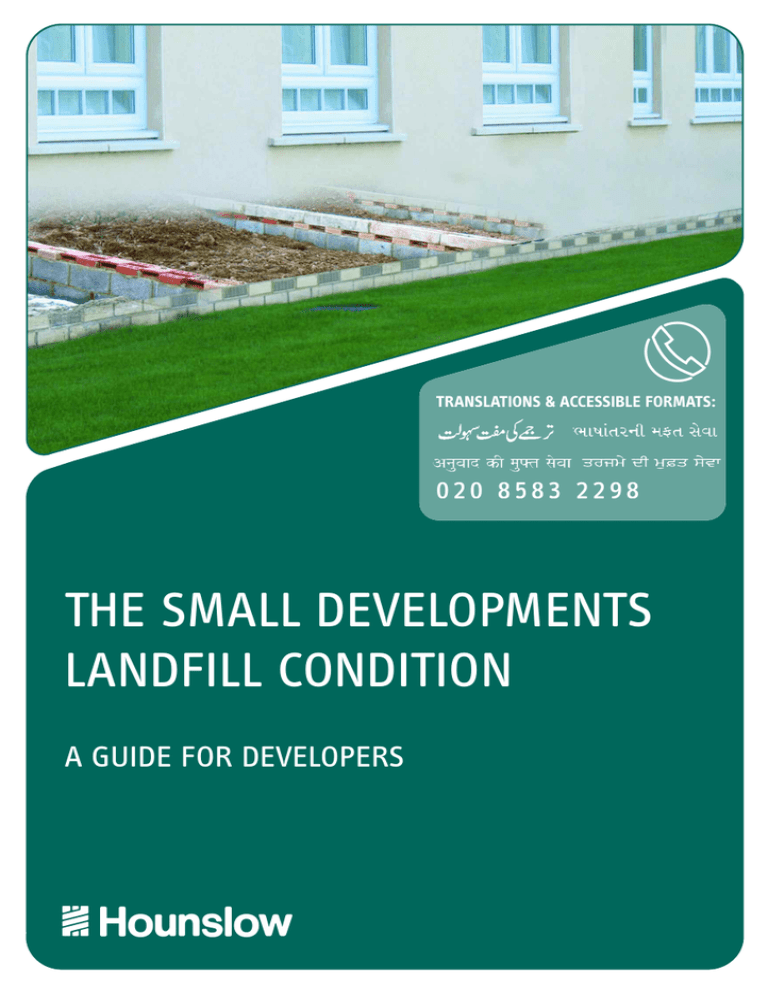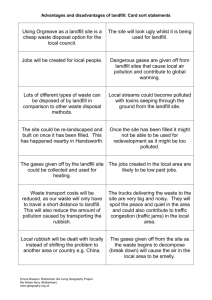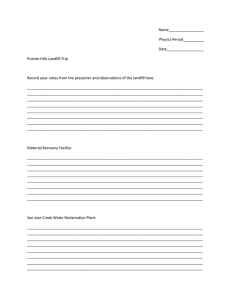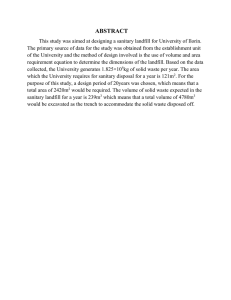
THE SMALL DEVELOPMENTS
LANDFILL CONDITION
A GUIDE FOR DEVELOPERS
WHAT IS THE PURPOSE OF THIS LEAFLET?
The leaflet is intended as a guide for residents undertaking small extensions to
existing homes subject to planning permission where the development is on, or
near areas of former landfill. It will provide information on how to comply with
the condition and give useful links for further information and contact details for
relevant council departments.
This leaflet has been produced by the London Borough of Hounslow Land Quality
Team who are the primary regulator for land contamination issues within the borough.
THE CONDITION WILL LOOK SOMETHING LIKE THIS:
Before the development hereby permitted commences the applicant must
either:
a.
Investigate the site for landfill gas to the satisfaction of
the LPA, to ascertain whether gas protection measures
are required. Where measures are required the details
shall be submitted to, and approved by, the LPA.
Or;
b.
The applicant shall install gas protection measures as a
precautionary measure without first investigating the
site. The details of these measures shall be submitted
to, and approved by, the LPA.
c.
For a. and b. all required measures shall be installed
before the development is first occupied.
Please Note:
If the landfill condition on your consent differs from
the one given above, further investigation and
assessment works will be required. Please refer to
the explanatory notes with the condition or contact
the Land Quality Team for details.
THE CONDITION EXPLAINED
l
l
The condition is a precautionary step to ensure that consideration is given
to all new buildings where there is a potential risk from ground gas contamination.
The condition is designed to address any potential ground gas risks and
ensure that the appropriate steps are taken to ensure the long-term safety
of the development and its users.
WHY COULD FORMER LANDFILL BE AN ISSUE?
l
l
Prior to 1974 there were no regulations for disposal of waste. Much of this
waste was landfilled without the safeguards modern landfill sites have to
protect public health and the environment.
Over time, gases including methane and carbon dioxide can be generated
as wastes breakdown in the ground. Problems can occur if these gases
accumulate within buildings to dangerous concentrations. Methane can be
explosive and carbon dioxide is an asphyxiant at high concentrations.
Below are a few ways that ground gases may enter buildings.
Key to ingress routes;
1 Through cracks in solid floors
2 Through construction joints
3 Through cracks in walls below ground level
4 Through gaps in suspended
floors
5 Through cracks in walls
6 Through gaps around service
pipes
7 Through cavities in
walls
Possible locations for gas accumulation:
A Wall cavities and roof voids
B Beneath suspended floors
C Within voids caused by settlement or
subsidence
D Drains and soakaways
A
B
D
4
C
1
3
2
5
2 6
7
Acknowledgement: Reproduced from
BRE report BR414 Protective Measures
for housing on gas-contaminated land.
By permission of Building Research
Establishment Ltd.
WHAT IS THE ‘ZONE OF CONCERN’?
l
l
l
l
The zone of concern is the area that immediately surrounds a former landfill. It usually extends 250 metres from the landfill site and ensures that
consideration is given to properties within close proximity to former landfills.
It is intended to protect buildings from any potential gases that may have
migrated from the landfill through the ground.
In some cases we have been able to reduce the extent of the zone where
gas levels are low.
Further information on the zone of concern can be found in Part C of the
Building regulations 2000 (as ammended) and the latest edition of
Approved Document C: Site Preparation and Resistance to Contaminants
and Moisture.
WHAT AM I REQUIRED
© Crown copyright. All rights reserved 100019263 2006.
WHAT AM I REQUIRED TO DO?
There are 2 options…
…Investigate the site for landfill gases to determine whether gas protection measures are
required and to what level.
OR
…Install gas protection measures into the base of
the building as a precautionary measure without
first testing the site.
WHICH OPTION SHOULD I CHOOSE?
l
For small extensions to existing buildings it is often believed to be cheaper
and more cost effective to install basic gas protection as a precautionary
measure instead of testing. Should testing show an issue with ground gases
at the site, protection measures will be required. Testing, may however,
show that protection measures are not necessary.
HOW DO I TEST FOR LANDFILL GAS?
l
l
l
The most commonly used methods of testing are monitoring of ground
boreholes or gas spike surveys. The ground should be monitored on at
least 3 occasions for methane, carbon dioxide and oxygen with the results
forwarded to the Local Planning Authority (LPA) for approval prior to
works continuing.
Where ground gas testing is to be undertaken, the full schedule of works
should be agreed with the Land Quality Team prior to their beginning.
The London Borough of Hounslow cannot offer a ground gas testing service; all testing and reporting should be undertaken by a competent environmental consultant. Please contact the Land Quality Team if you require
further details on testing for landfill gases.
WHAT IS GAS PROTECTION?
l
Gas protection usually consists of a combination of precautionary measures
built into the ground floor fabric of buildings that significantly reduces the
possibility of ground gases moving into buildings and accumulating to dangerous levels.
WHAT PROTECTION WOULD BE REQUIRED?
l
l
l
l
l
A gas membrane is required as a minimum. Gas membranes are similar to
the ‘Damp Proof Membrane’ (DPM) but thicker and have welted seams;
they act as a barrier reducing the risk of gases entering buildings. In addition, passive ground ventilation measures may be required if the building is
on or adjacent to the former possible landfill. The level of protection
required will vary depending on the nature of the site so the specific
designs should always be agreed with your Building Control Officer.
Membranes should be of polyethylene material and at least 300 micrometers (1200 gauge) in thickness. They should be sealed across the entire floor
slab and linted to the wall DPC (damp proof course) and sealed around all
service entry points.
It should be installed to correct BBA certification and in accordance with
the manufacturers instructions.
All protection measures should comply with the Building Regulations 2000
(as ammended): Approved Document C, Site Preparation and resistance to
contaminants and moisture. Your architect and builder should be aware of
this document.
Under the Town and Country Planning Act 1990, it is the developers
responsibility to ensure that the required actions of planning conditions
are undertaken and met to the approval of the Local Planning Authority.
HOW CAN I GET FURTHER INFORMATION?
The Land Quality Team holds information about former landfilling activities
across the borough. This information has been collected from various sources
and summarised into a public register, which is available for public viewing at
our Civic Centre Offices in Hounslow during normal office hours. Please contact
the Land Quality Team if you wish to make an appointment.
USEFUL DOCUMENTS AND LEGISLATION
Links to many of the followings resources can be found on our website or from
your local library.
Town and Country Planning Act, 1990
Building Regulations 2000 Part C: Site Preparation and Resistance to
Contaminants and Moisture
Planning Policy Statement 23 (PPS23): Planning & Pollution Control
PPS 23 Annex II, Land Affected by Contamination.
Environment Agency (EA) & Building Research Establishment (BRE) Publication
414: Protective measures for housing on gas-contaminated land.
The Environment Agency’s reference number for this manual is R&D Technical
Report P336.
Building Research Institute (BRE) Publication 212: Construction of new buildings
on gas-contaminated land.
EA & NHBC: Guidance for the safe development of housing on land affected by
contamination. EA R&D Publication 66.
Her Majesty’s Inspectorate of Pollution: Waste Management Paper 27The Control of Landfill Gas
CONTACT US
Further information and links to related sites can be found on our website:
www.hounslow.gov.uk
If you have any queries or would like further information, please contact us
on:
LAND QUALITY TEAM:
Tel: 020 8583 5062/4877
Fax: 020 8583 5134
Email: landquality@hounslow.gov.uk
BOROUGH PLANNING OFFICE:
Please contact your local area team:
Telephone
Feltham, Bedfont, Hanworth & Hatton
020 8583 4940
Heston, Cranford & Hounslow
020 8583 4965
Isleworth & Brentford
020 8583 4970
Chiswick, Gunnersbury & Turnham Green
020 8583 4998
Fax:
020 8583 4900
Email: planningcomments@hounslow.gov.uk
BUILDING CONTROL:
Tel:
020 8583 5403/04
Fax:
020 8583 5405
Email: buildingcontrol@hounslow.gov.uk
Please address all written correspondence to the appropriate team at the
following address:
London Borough of Hounslow
The Civic Centre
Lampton Road
HounslowTW3 4DN
Printed on recycled paper







